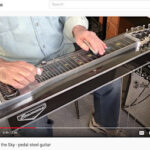The dream of every guitarist who wants to compose or notate music is to play their instrument and have it instantly translated into sheet music. Imagine strumming a chord or shredding a solo and seeing the notes magically appear in notation software like Sibelius. This would streamline the songwriting process and make music transcription incredibly efficient. But is this direct guitar-to-notation transcription a reality, or still just a hopeful aspiration? Let’s explore the possibilities and limitations of turning your guitar performance into written music.
The Challenge of Guitar Transcription
Many guitarists have sought a seamless way to convert their playing into notation. The initial thought often revolves around using standard audio interfaces with notation software. However, the nuances of guitar playing pose significant challenges for accurate automatic transcription. As experienced users in online forums have discussed, software struggles to interpret the complexities of guitar techniques. Subtleties like bends, slides, hammer-ons, pull-offs, and even chord voicings can be misinterpreted or missed entirely by transcription software.
Early attempts using tools like AudioScore Lite, often bundled with Sibelius, have shown limited success, particularly with polyphonic playing (chords). Users report that while these tools might handle simple, monophonic lines, transcribing anything more complex results in numerous errors requiring extensive manual correction. The time spent fixing these errors can often exceed the time it would take to notate the music from scratch.
Existing Solutions and Options
Despite the challenges, there are approaches that offer varying degrees of success in guitar-to-notation transcription.
MIDI Guitar Pickups and Converters: One established method involves using a MIDI guitar or a MIDI pickup system. These systems translate the physical vibrations of the guitar strings into MIDI data, which can then be directly imported into notation software. Think of it like a keyboard, but in guitar form. While MIDI guitars can offer a more direct pathway to notation, especially for monophonic lines and simpler chord work, they are not without limitations. The technology is still evolving, and achieving perfect accuracy, especially with complex guitar techniques and polyphonic passages, can be difficult.
Software Solutions (Audio to MIDI Conversion): Software like Melodyne and JamOrigin MIDI Guitar (as mentioned by forum users) represent advancements in audio-to-MIDI conversion. Melodyne, while primarily known for vocal tuning and manipulation, can also analyze polyphonic audio and convert it to MIDI. JamOrigin MIDI Guitar is specifically designed to turn your electric guitar into a polyphonic MIDI instrument using standard audio input. These tools can yield better results than basic audio transcription, but they are still not perfect. The generated MIDI data often requires editing to correct errors and refine the musical notation. For example, while JamOrigin is praised for live performance and recording MIDI, converting that MIDI into accurate notation remains a separate, often laborious step.
The Verdict: Realistic Expectations
The consensus among guitarists who have experimented with guitar-to-notation software is one of cautious optimism tempered by realism. While the technology is improving, fully automated and perfectly accurate guitar transcription remains elusive, especially for complex musical pieces. For simple monophonic melodies or basic chord progressions, current software and MIDI guitar solutions can be helpful starting points. However, for professional-quality scores and intricate guitar parts, manual transcription and editing are still often necessary.
Ultimately, while the dream of instant guitar-to-notation is appealing, guitarists should approach current technology as a tool to assist, rather than replace, traditional music notation methods. Experiment with available options, but be prepared to invest time in editing and refining the results to achieve accurate and musically meaningful notation.

